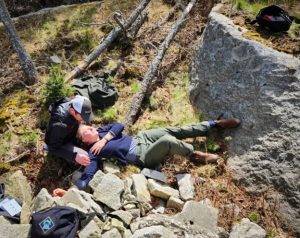When engaging in remote exploration or adventuring, we plan excessively. We worry about logistics. We worry about our gear, our meals, our put-ins and take-outs, and a myriad of other things. What most don’t worry about is what if we or someone in our group or someone we might meet along the way is injured. The common thinking is “well, I have a first aid kit to take with me”. The questions become:
- Do you know what to do?
- Do you know what is even in the kit or how to use it?
- Have the medications expired or disintegrated to the point where they are ineffective?
- Is the kit stocked with what is really needed or adequate for the length of the trip or the number of people in the group?
In my many years of wilderness adventuring and exploration, I have had to administer first aid many times. Thankfully, none of them were life threatening. My training as a Special Forces Green Beret medic prepared me well.

But since that training was many years ago, it was easy for the knowledge to become obsolete due to either not using it or advances in wilderness medicine that have greatly evolved. To keep up to date with the subject, I took a Basic Life Saving Course while serving with a Search & Rescue Team. From having to treat injuries during a night parachute jump in the swamps, to heat exhaustion in the desert, and cuts and bruises from falls in the woods, I have had to administer first aid to my teammates and members of the expeditions over the years.
Not everyone has had the experience of going through a year-long training course like I did. So, what is the best way to ensure you will know what to do in the field? The premier training that I would recommend is taking a 2-day Wilderness First Aid (WFA) class given by NOLS instructors. The National Outdoor Leadership School (NOLS) is the gold standard and leader in Wilderness Training. They offer the course across the US and to find one near you, check with their website, REI, or other wilderness retailers that have adventure programs. The cost is a little over $300. If you want more advanced training, they also offer classes such as: Wilderness First Responder and even a Wilderness EMT course. Again, the two-day class is a great starting point.
Classes are held indoors for parts of the training and outdoors, regardless of weather. Here is the agenda for the WFA Couse. NOLS reserves the right to make changes:
Day 1
- Morning:
- Infection Control and Personal Protective Equipment
- Patient Assessment System
- Afternoon:
- Emergency and Evacuation Plans
- Spine Injury
- Head Injury
- Shock
Day 2
- Morning:
- Wilderness Wound Management
- Musculoskeletal Injury
- Afternoon:
- Heat Illness
- Cold Injury
- Chest Pain,
- Abdominal Pain
- Shortness of Breath
- Altered Mental Status
- Anaphylaxis
You can find more information and write-ups on their site: https://www.nols.edu/en/coursefinder/courses/wilderness-first-aid-WFA/

First Aid Kits
It is advisable and strongly recommended that you should be carrying a First Aid Kit or there should be at least one carried by someone in the group on every outing. The issue becomes what constitutes an adequate kit for the expedition? There are as many opinions as there are options.
An outdoor educator, Brett Friedman, has years of experience and has taught over a hundred WFA courses for NOLS. He is featured along with a brief background on my website (https://reflectionsoffthegrid.com/explorer/brett-friedman/). He produced an outstanding video on this very subject; https://www.youtube.com/watch?v=f2wRasXr1qI&ab_channel=AdventureOtaku. On his YouTube channel, there are also many other Wilderness Medicine videos that are worth watching.
I have two kits that I carry, one for day/weekend trips (like the one in Brett’s video) and a large group kit (my version of Brett’s other sizes) for when I lead folks on an adventure or one of longer duration.
Knowing how to use these kits can be puzzling if it has been a while since you took the course or if you’ve never taken a course. Thinking that the little insert that usually accompanies the contents of the kit is one option, granted not the best. There are a couple of books I recommend.
- “NOLS Wilderness Medicine” by Tod Schimelpfenig
- “Hikers’ and Backpackers Guide for Treating Medical Emergencies” by Patrick Brighton, M.D.
The latter is thin and easier to carry on an adventure.
There are also some adventurers that are relatively new to the outdoors and believe they can rely on communication technology. Electronic gear such as PLBs, VHF Radios, GPSs with SOS capability, and handheld small, dedicated satellite communicators (e.g. inReach like devices), and yes, even cell phones are starting to provide this capability. However, they do not replace the need for you to have the knowledge to perform wilderness first aid for yourself or a member of your group.


